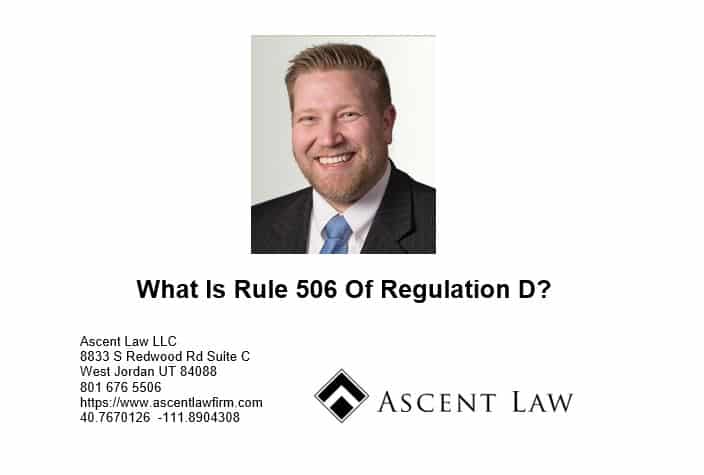Rule 503 Regulation D : What it is
Rule 503 Regulation D: What It Is
The Rule 503 Regulation D is an important regulation that governs the offering and sale of securities to private investors. It is a provision under the Securities Act of 1933 and provides guidelines for companies looking to raise capital through private placements. In this article, we will delve into the details of Rule 503 Regulation D, its purpose, requirements, and its impact on the investment landscape.
Understanding Rule 503 Regulation D
Rule 503 Regulation D provides exemptions from the registration requirements of the Securities Act for certain private offerings. Private offerings refer to the sale of securities to a limited number of sophisticated and accredited investors, including high net worth individuals, institutions, and other qualified buyers. These exemptions allow companies to raise capital without undergoing the rigorous and costly process of registering their securities with the Securities and Exchange Commission (SEC).

Image Source: FreedomWorks
The Purpose of Rule 503 Regulation D
The primary purpose of Rule 503 Regulation D is to facilitate capital formation for small businesses and startups by providing an exemption from registration requirements. By allowing companies to raise funds from private investors, the SEC aims to foster entrepreneurial growth and innovation in the economy. It also recognizes that private investors, particularly accredited individuals and institutions, have the knowledge and resources to conduct their own due diligence and investment decisions.

Image Source: Ronald Reyna
Requirements of Rule 503 Regulation D
In order to qualify for the exemptions under Rule 503 Regulation D, companies must comply with certain requirements:
- Accredited Investors: Companies must limit their offerings to accredited investors who possess the financial sophistication and ability to bear the risks associated with private investments. This helps protect retail investors who may not have the same level of investment knowledge.
- Limited Number of Non-Accredited Investors: The exemption also allows a limited number of non-accredited investors to participate. However, additional requirements and disclosures are imposed to ensure they have access to adequate information and protection.
- General Solicitation Restrictions: Companies must refrain from employing general solicitation or advertising to attract investors. This helps maintain the private nature of the offering and ensures that only eligible investors participate.
Benefits of Rule 503 Regulation D
Rule 503 Regulation D offers several benefits to companies and investors alike:
- Efficient and Cost-Effective Capital Raising: By providing exemptions from registration, Rule 503 Regulation D reduces the regulatory burden and associated costs for companies seeking capital.
- Access to Investment Opportunities: Accredited investors gain access to a broader range of investment opportunities, including early-stage companies and alternative assets.
- Promotes Economic Growth: The availability of private capital allows small businesses and startups to grow and innovate, contributing to job creation and overall economic expansion.
Subheading 1: Potential Risks for Investors
While Rule 503 Regulation D offers significant benefits, it is important for investors to be aware of certain risks:
- Lack of Liquidity: Investments in private offerings are often illiquid, meaning they cannot be easily bought or sold on public exchanges. Investors may need to hold their investments for extended periods before being able to liquidate them.
- Higher Risk Profile: Private offerings typically involve higher risks compared to publicly-traded securities. Startups and early-stage companies often face a higher likelihood of failure, which may result in a loss of investment.
- Less Regulatory Oversight: Since private offerings are exempt from SEC registration, they are subject to fewer regulations and oversight. Investors should conduct thorough due diligence to assess the legitimacy and potential risks associated with the offering.
Subheading 2: Frequently Asked Questions (FAQs)
1. What types of securities can be offered under Rule 503 Regulation D?
Rule 503 Regulation D allows for the offering of various securities, including stocks, bonds, limited partnership interests, and other equity or debt instruments.
2. Are there any restrictions on the amount of capital that can be raised under Rule 503 Regulation D?
No, there are no specific restrictions on the amount of capital that can be raised through private offerings under Rule 503 Regulation D. However, the SEC imposes different requirements and disclosures based on the amount of capital raised.
3. Are non-accredited investors completely excluded from participating in private offerings?
No, non-accredited investors are not completely excluded. Rule 503 Regulation D allows a limited number of non-accredited investors to participate, provided they meet certain requirements and receive additional disclosures.
Conclusion
Rule 503 Regulation D plays a vital role in facilitating capital formation and fostering investment opportunities for both companies and accredited investors. By providing exemptions from registration requirements, this regulation enables startups and small businesses to raise funds efficiently and cost-effectively while allowing investors access to potentially lucrative private investments. However, it is crucial for investors to carefully evaluate the risks associated with private offerings and conduct thorough due diligence to make informed investment decisions.
What Is Rule 506 Of Regulation D? | Ronald Reyna
 Image Source : mott11.wordpress.com
Image Source : mott11.wordpress.com regulation rule
The Regulation Madness Is Coming To An End | FreedomWorks
 Image Source : www.freedomworks.org
Image Source : www.freedomworks.org regulation regulations madness coming end freedomworks
The Book On PPM's: Regulation D Rule 506 Edition - YouTube
 Image Source : www.youtube.com
Image Source : www.youtube.com regulation rule
Alpha Rule: Photo
 Image Source : alpharule.tumblr.com
Image Source : alpharule.tumblr.com Rule 504 Regulation D | Private Lending Made Easy
regulation rule securities familiar 1933 seed act capital known also
PPM Regulation D Rule 506 | In Addition To A Complete Explan… | Flickr
 Image Source : www.flickr.com
Image Source : www.flickr.com Rule 504 Offerings - Regulation D Attorneys
 Image Source : www.securitieslawyer101.com
Image Source : www.securitieslawyer101.com Rule : 196
 Image Source : www.reddit.com
Image Source : www.reddit.com Regulation rule. Ppm regulation d rule 506. Regulation regulations madness coming end freedomworks. Regulation rule securities familiar 1933 seed act capital known also. Regulation rule